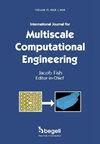利用磁共振成像和深度学习技术为多发性硬化症分类建立高效的分割模型
IF 1.4
4区 工程技术
Q2 ENGINEERING, MULTIDISCIPLINARY
International Journal for Multiscale Computational Engineering
Pub Date : 2024-01-01
DOI:10.1615/intjmultcompeng.2023050387
引用次数: 0
摘要
采用深度学习的分割模型能在多种医学影像复杂数据资源和对巨大病理有重要意义的公共数据资源上取得成功。在识别多发性硬化症的过程中,从磁共振成像(MRI)序列中观察整个肿瘤是一项复杂的工作。此外,有必要在预后阶段从图片中识别出小肿瘤,以便提供良好的治疗。深度学习辅助识别模型解决了传统模型中数据不平衡和假阳性结果较多的问题。此外,这些方法还能很好地权衡精确度和召回率。因此,我们开发了最新的深度学习辅助核磁共振图像分割和分类模型,用于在初始阶段检测多发性硬化症。在这里,核磁共振成像图片最初是从传统的在线数据库中收集的。收集到的图像直接用于图像分割过程,其中采用了多尺度自适应 TransResunet++ (MSAT)来执行适当的病变分割。在开发的随机对立蝉群优化(ROCSO)的支持下,对 MSAT 中的属性进行了优化。然后,对分割后的图片进行分类处理,利用基于混合和稀释卷积的自适应残留注意力网络(HDCARAN)对磁共振成像图像中的病变进行有效分类,从而检测出患者是否患有多发性硬化症。在此,HDCARAN 中的属性通过相同的 ROCSO 进行调整。实施结果通过之前开发的 "HDCARAN "模型进行分析。本文章由计算机程序翻译,如有差异,请以英文原文为准。
Efficient segmentation model using MRI images and deep learning Techniques for Multiple Sclerosis Classification
The segmentation models employing deep learning offer successful outcomes over multiple medical image complex data resources and public data resources important for huge pathologies. During the identification of multiple sclerosis, the observation of entire tumors from the Magnetic Resonance Imaging (MRI) sequence is complex. Furthermore, it is necessary to identify the small tumors from the pictures in the prognosis phase to offer good treatment. The deep learning-assisted identification models solve the issue of the imbalance data and the false positive results are more in the conventional models. Besides, these methodologies offer a good tradeoff between the precision measure and recall measure. Thus, the latest deep learning-assisted MRI image segmentation and categorization model is developed to detect multiple sclerosis at the initial stage. Here, the MRI pictures are initially gathered from traditional online databases. The gathered images are directly given to the image segmentation process, where the Multi-scale Adaptive TransResunet++ (MSAT) is adopted to perform the lesion segmentation appropriately. The attributes present in the MSAT are optimized with the support of the developed Random Opposition of Cicada Swarm Optimization (ROCSO). Then, the segmented pictures are subjected to the categorization process, where the Hybrid and Dilated Convolution-based Adaptive Residual Attention Network (HDCARAN) is utilized to categorize the lesions from the MRI images very effectively to detect the multiple sclerosis of patients. Here, the attributes present within the HDCARAN are tuned via the same ROCSO. The implementation results are analyzed through the previously dev
求助全文
通过发布文献求助,成功后即可免费获取论文全文。
去求助
来源期刊
CiteScore
3.40
自引率
14.30%
发文量
44
审稿时长
>12 weeks
期刊介绍:
The aim of the journal is to advance the research and practice in diverse areas of Multiscale Computational Science and Engineering. The journal will publish original papers and educational articles of general value to the field that will bridge the gap between modeling, simulation and design of products based on multiscale principles. The scope of the journal includes papers concerned with bridging of physical scales, ranging from the atomic level to full scale products and problems involving multiple physical processes interacting at multiple spatial and temporal scales. The emerging areas of computational nanotechnology and computational biotechnology and computational energy sciences are of particular interest to the journal. The journal is intended to be of interest and use to researchers and practitioners in academic, governmental and industrial communities.

 求助内容:
求助内容: 应助结果提醒方式:
应助结果提醒方式:


